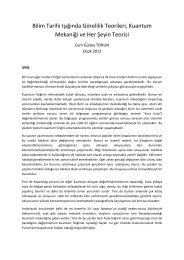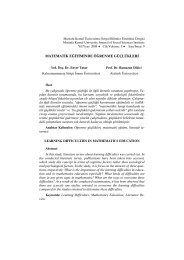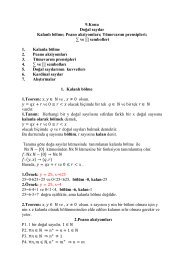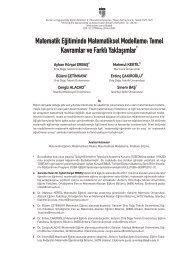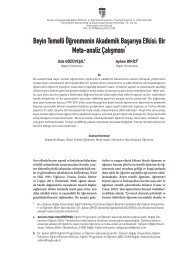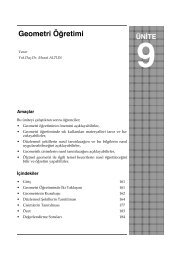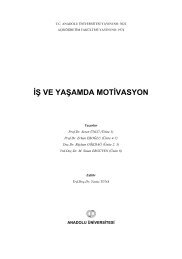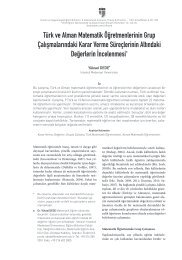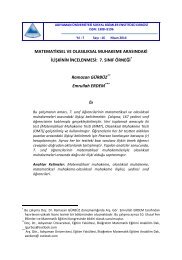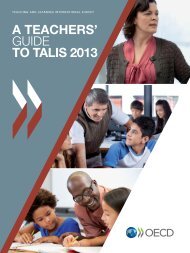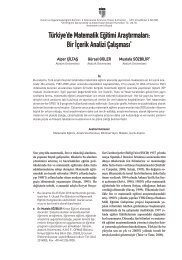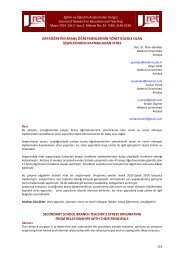Gardner, R. C., & MacIntyre, P. D. (1993). A student’s contributions to second language.Pasrt II: Affective variables. Language Teaching, 26(1), 1-11.Hamers, J., & Blanc, M. (2000). Bilinguality and bilingualism. Cambridge, U.K.: CambridgeUniversity Press.Herdina, P., & Jessner, U. (2002). A Dynamic Model of Multilingualism: Perspectives ofChange in Psycholinguistics. Clevedon: Multilingual Matters.Joaristi, L., Lizasoain, L., Lukas, J. F., & Santiago, K. (2009). Trilingualism (Spanish,English and Basque) in the educational system of the Basque country. InternationalJournal of Multilingualism, 6(1), 105-126.Kemp, C. (2007).Strategic Processing in Grammar Learning: Do Multilinguals Use MoreStrategies? International Journal of Multilingualism, 4(4), 241-261.Kneipp, L. B., Kelly, K. E., Biscoe, J. D., & Richard, B. (2010). The impact of instructor’spersonality characteristics on quality of instruction. College Student Journal, 44(4),901-906.McLaughlin, B., & Nayak, N. (1989). Processing a new language: Does knowing otherlanguages make a difference? In H. W. Dechert & M. Raupach (Eds.), Interlingualprocess (pp. 5-16). Tübingen: Gunter Narr.Mohanty, A. K., & Perregaux, C. (1997). Language acquisition and bilingualism. In J. W.Berry, P. R. Dasen, & T.S. Saraswathi (Eds.), Handbook of Cross-Cultural Psycholoy.Vol. 2: Basic Processes and Human Development (pp. 217-53). Boston MA: Allynand Bacon.Nayak, H., Hansen, N., Krueger, N., & McLaughlin, B. (1990). Language-learning strategiesin monolingual and multilingual adults. Language Learning, 40, 221-44.Oxford, R. L. (1990). Language learning strategies: What every teacher should know.Boston, MA: Heinle & Heinle.Oxford University Press. (2011). English Placement Test. Retrieved November 18, 2012,from http://fdslive.oup.com/www.oup.com/elt/general_content/cz/solutionsplacementtest.pdf?cc=us&selLanguage=en&mode=hub72
Öztürk, G. (2013). Job Burnout Experienced by Turkish Instructors of English Working atState Universities. International Online Journal of Educational Science, 5(3), 587-597.Purdie, N., & Oliver, R. (1999). Language Learning Strategies used by bilingual school-agedchildren. System, 27, 375-388.Psaltou-Joycey, A., & Kantaridou, Z. (2009). Plurilingualism, language learning strategy useand learning style preferences. International Journal of Multilingualism, 6(4), 460-474.Saqlain, N., & Mahmood, Z. (2013). English Language Instructors’ perceptions abouttechnology-based language learning at Northern Border University in Saudi Arabia.The Turkish Online Journal of Educational Technology, 12(2), 106-110.Saunders, K. T. (2001). The influence of instructor native language on student learning andinstructor ratings. Eastern Economic Journal, 27(3), 345-353.Sung, K. Y. (2011). Factors influencing Chinese language learners’ strategy use. InternationalJournal of Multilingualism 8(2), 117-134.Valdés, G., & Figueroa, R. A. (1994). Bilingualism and Testing: A Special Case of Bias.Norwood, NJ: Ablex Publishing.Wenden, A. L., & Rubin, J. (1987). Learner strategies in language learning. EnglewoodCliffs: Prentice-Hall International.Wiebe, G., & Kabata, K. (2010). Students’ and Instructors’ Attitudes toward the use of CALLin foreign language teaching and learning. Computer Assisted Language Learning,23(3), 221-234.73
- Page 1 and 2:
ISSN: 2146-7676UFUK ÜNİVERSİTES
- Page 3 and 4:
UFUK ÜNİVERSİTESİSOSYAL BİLİM
- Page 5 and 6:
SUNUŞDergimizin 2014 yılı ilk sa
- Page 7 and 8:
A NEED-BASED EVALUATIONOF A PREPARA
- Page 9 and 10:
In the literature on language teach
- Page 11 and 12:
focus teaching on this. Accordingly
- Page 13:
International Relations) were 20 (7
- Page 16 and 17:
questionnaire in their English-medi
- Page 18 and 19:
REFERENCESAlagözlü, N. K. (1984).
- Page 20 and 21:
APPENDIX A1 STUDENT QUESTIONNAIRE
- Page 23 and 24: 24. Converting short notes into
- Page 27 and 28: The Role Of Gender On University St
- Page 29 and 30: (Johnson 2001; Türküm, 2005). Joh
- Page 31 and 32: Table 1 : Means and Standard Deviat
- Page 33 and 34: 2.3 ProcedureEthical permission to
- Page 35 and 36: age and attitude toward help seekin
- Page 37 and 38: Economics and Administrative Scienc
- Page 39 and 40: REFERENCESAddis, M. E., & Mahalik,
- Page 41 and 42: Koydemir-Özden, S. (2010). Self-as
- Page 43 and 44: LİSE ÖĞRENCİLERİNİN MESLEKİ
- Page 45 and 46: göre mesleki bakımdan daha önce
- Page 47 and 48: Araştırmanın amacıMesleki olgun
- Page 49 and 50: Tablo 1: Lise Öğrencilerinin Mesl
- Page 51 and 52: Lise öğrencilerinin karar verme s
- Page 53 and 54: KAYNAKÇA Acıbozlar, Ö. (2006). Y
- Page 55: Oğuz, Ö. (2008). Lise öğrencile
- Page 58 and 59: 1. IntroductionDifferent from the p
- Page 60 and 61: noteworthy to mention that multilin
- Page 62 and 63: The findings indicate that multilin
- Page 64 and 65: Table 1. Descriptives statistics fo
- Page 66 and 67: overall six factor structure which
- Page 68 and 69: wider variety of strategies with a
- Page 70 and 71: inclusion of instructors who are no
- Page 74 and 75: AppendicesAppendix A- English Profi
- Page 77 and 78: ELT Student Teachers’ Evaluations
- Page 79 and 80: Reflective Teaching in TurkeyIn Tur
- Page 81 and 82: Table 1: Reliability Analysis o
- Page 83 and 84: Table 4: Mean and standard dev
- Page 85 and 86: Table 9: Mean and standard dev
- Page 87 and 88: ReferencesAkbari, R. (2007). Reflec
- Page 89: Pollard, A. & Triggs, P. (1997) Ref
- Page 92 and 93: 1. GİRİŞEğitim ve program geli
- Page 94 and 95: Genelgeçer tek bir bilimsel sürec
- Page 96 and 97: Program geliştirmedeki yenilikleri
- Page 98 and 99: -Elde ettiği sonuçlardan hareket
- Page 100 and 101: “İnternet Üzerinden Öğrenme
- Page 102 and 103: de sınıf içi dersler de öğrenm
- Page 104 and 105: teknik ve pedagojik uzmanlar gerekt
- Page 106 and 107: 3. Proje ekibinin kurulması4. Plan
- Page 108 and 109: KAYNAKÇABigdoli, H. (2004). The In
- Page 110 and 111: 110
- Page 112 and 113: Hiçbir öğrenci bir diğeriyle ay
- Page 114 and 115: İçerik sınıfta nelerin öğreti
- Page 116 and 117: (MEB, 2006; Tomlinson, 2005). Ek ol
- Page 118 and 119: - Öğrencilerden gereksinim duyduk
- Page 120 and 121: desteklerine gereksinim duydukları
- Page 122 and 123:
KAYNAKÇAAlberto P. A, ve Troutman
- Page 124 and 125:
124
- Page 126 and 127:
1.GİRİŞBuradaki araştırma OECD
- Page 128 and 129:
öğretilenleri almışlar mı diye
- Page 130 and 131:
edileceğini araştırmaz, ancak bu
- Page 132 and 133:
yaşarlar: Çok fazla sayıda koşu
- Page 134 and 135:
• Birincil Stratejiler ve Destek
- Page 136 and 137:
ir dönemdir. Özellikle artan yaş
- Page 138 and 139:
2. Hipotez: Öğretmenlerin coğraf
- Page 140 and 141:
Tablo 7 Öğretmenlerin Coğrafi
- Page 142 and 143:
stratejileri”ne yönelik bilişse
- Page 144 and 145:
sonuçları χ 2 (12, N =407) = 13,
- Page 146 and 147:
sebebiyet verir. Bunun önemli bir
- Page 148 and 149:
KAYNAKÇAArtelt, C., Stanat, P., Sc
- Page 150 and 151:
Lieteratur. 10. Sonderheft: Lesesoz
- Page 152 and 153:
YAYIM ALANI, YAZIM KURALLARI ve YAZ
- Page 154:
• Birebir alımlar “…” İş





